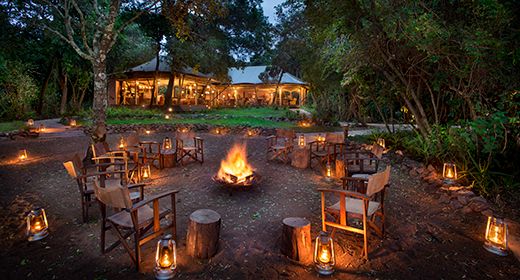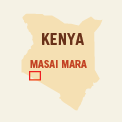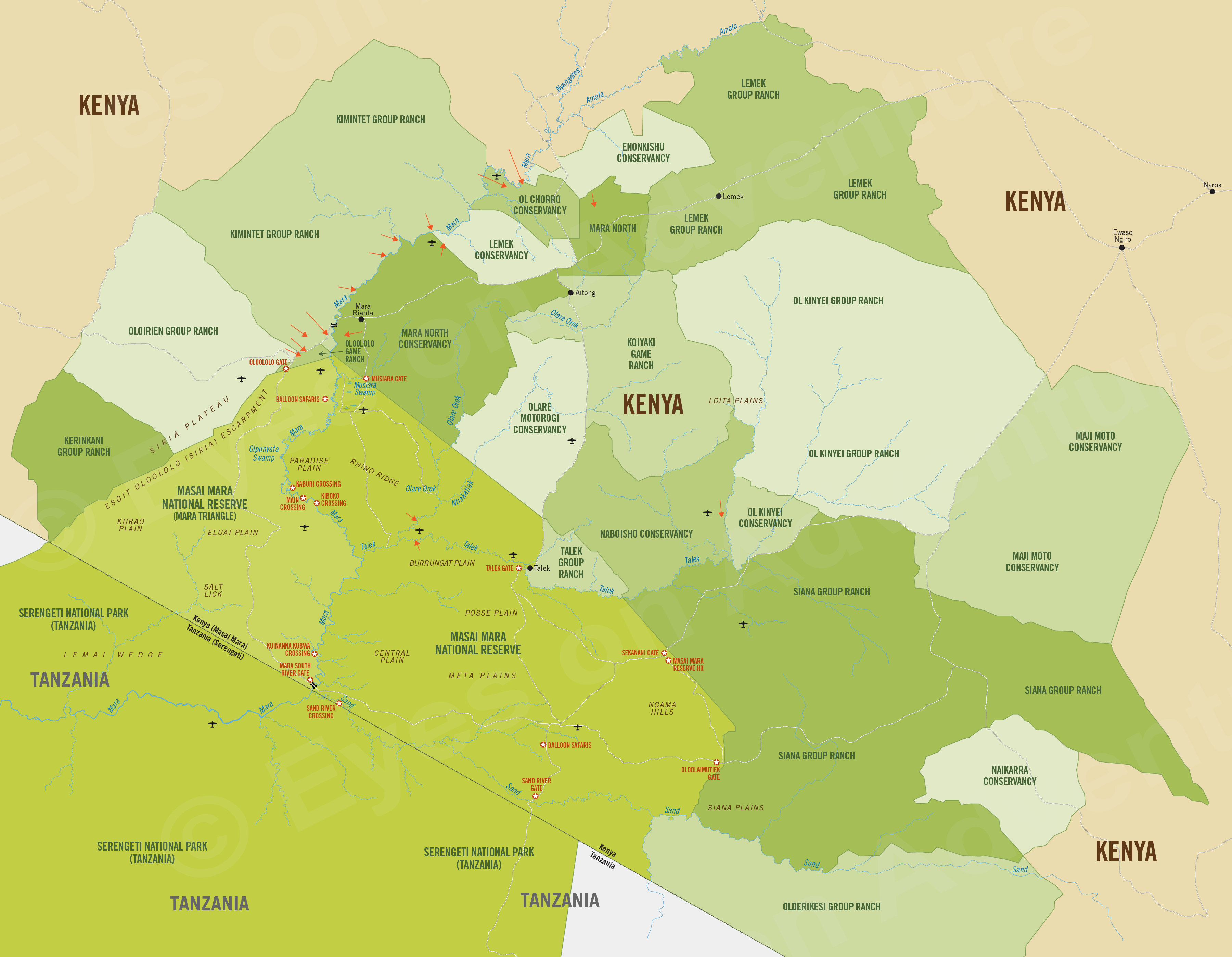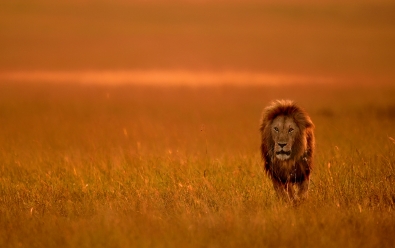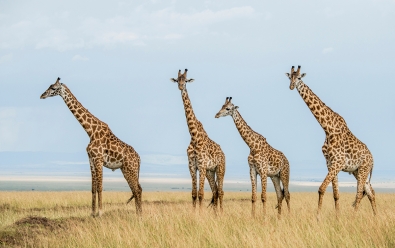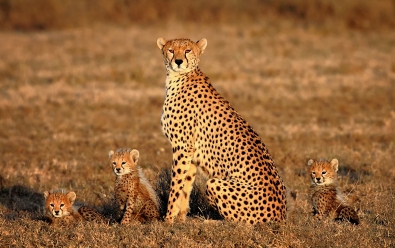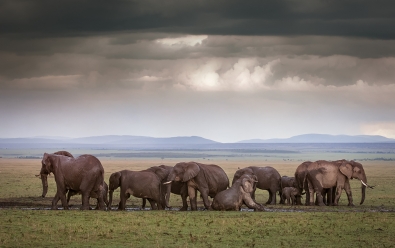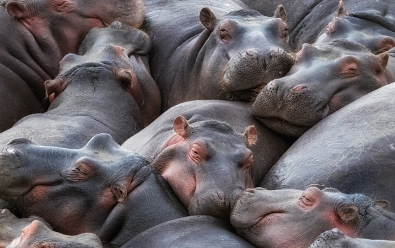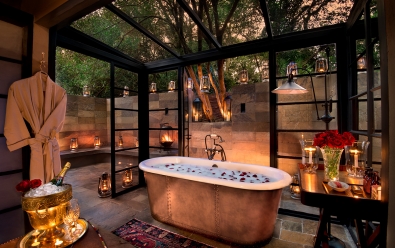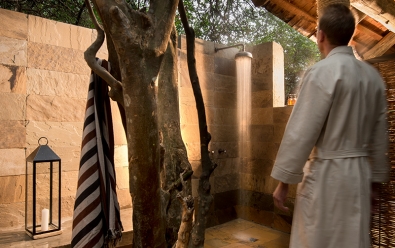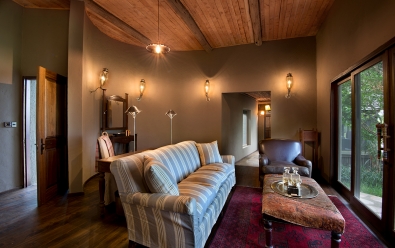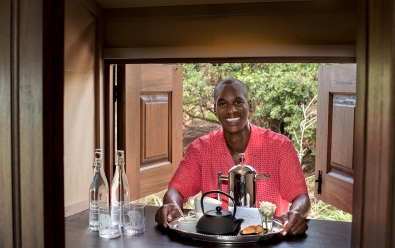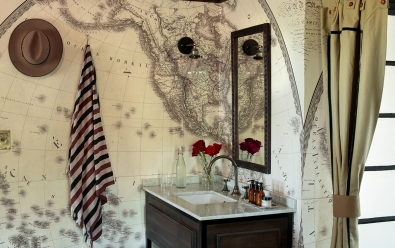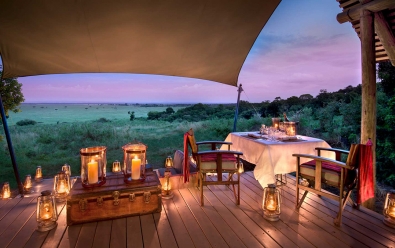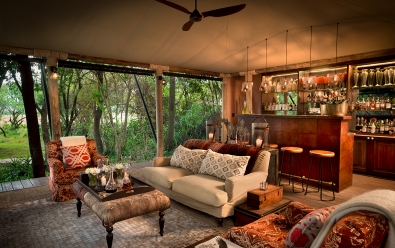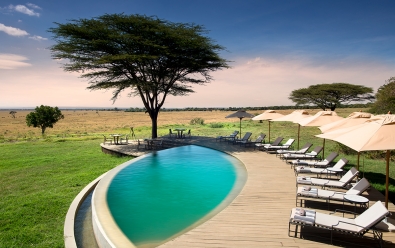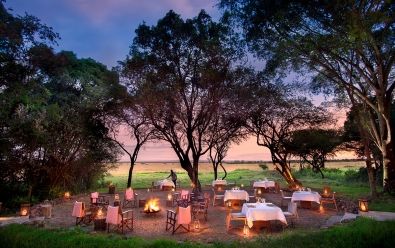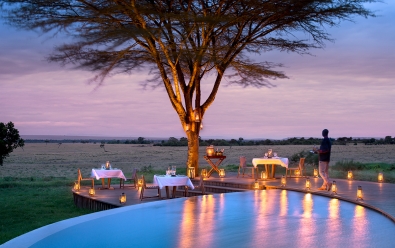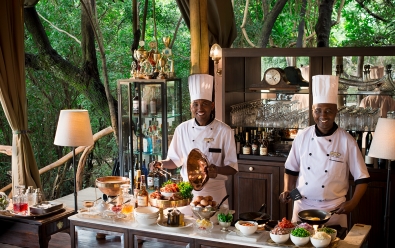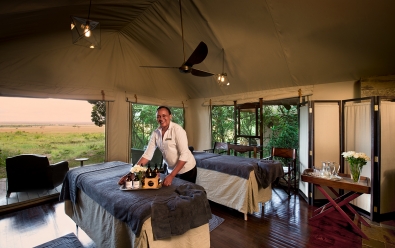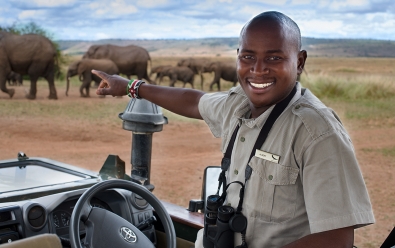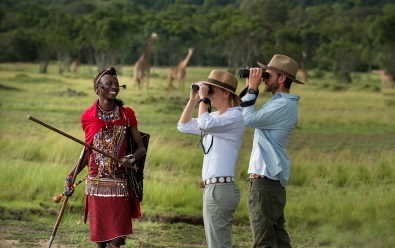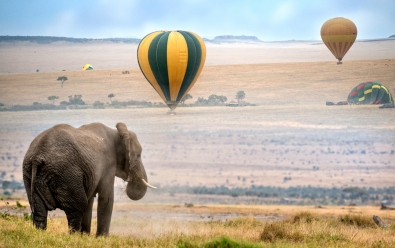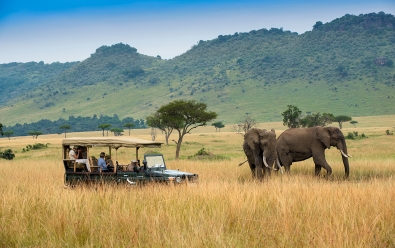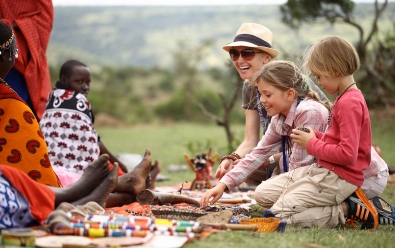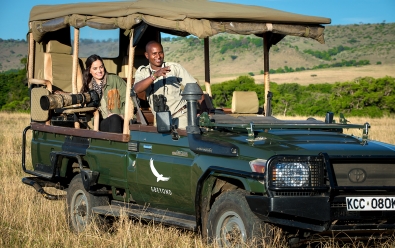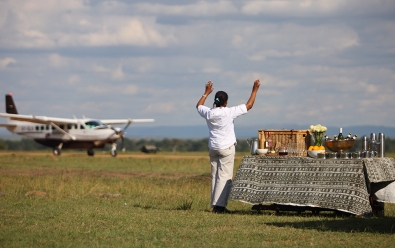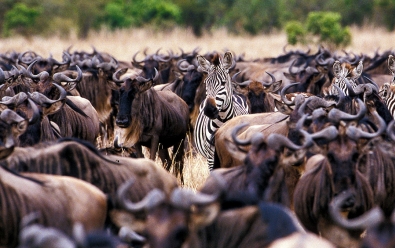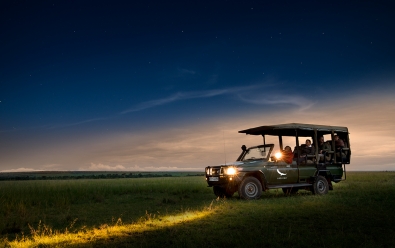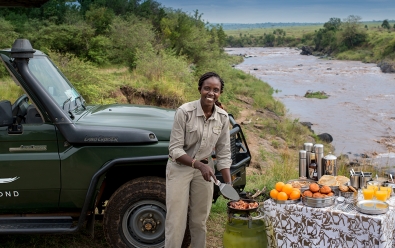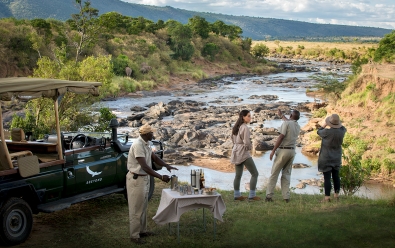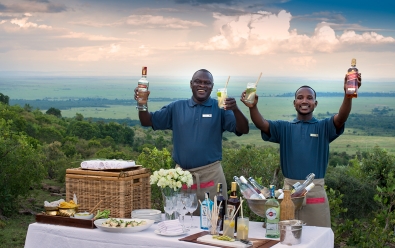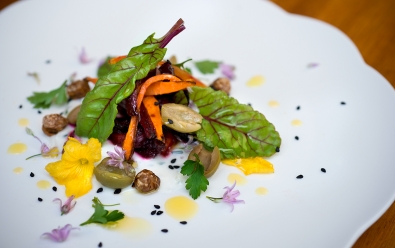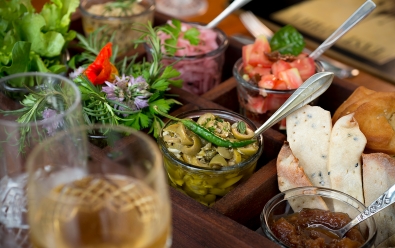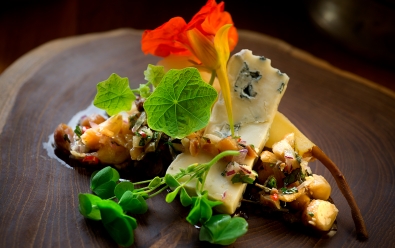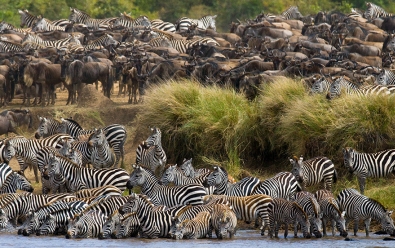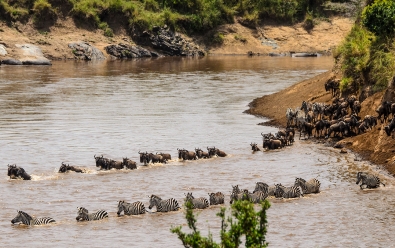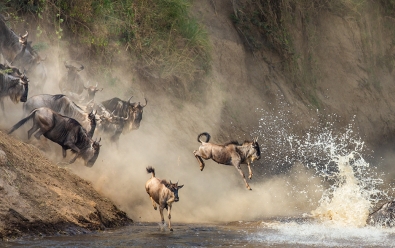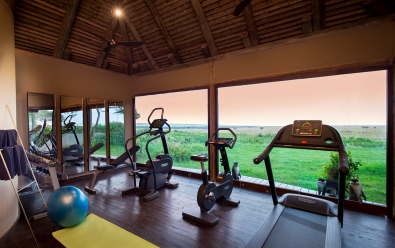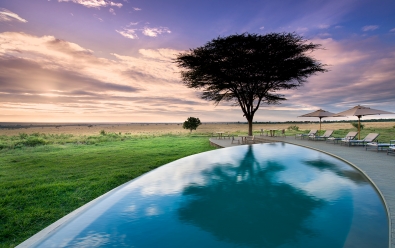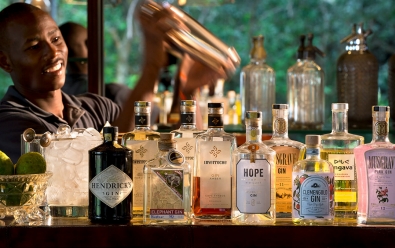Bateleur Camp
Highlights
- Set in a private concession with low tourist densities
- Masai Mara is one of the richest and most diverse wildlife areas in the world
- In the path of the Great Migration of two million herbivores
- Game drives, walking, and cultural activities with the Maasai people
Location
- Oloololo Group Ranch
- Greater Masai Mara
- Southwest Kenya
Bateleur is a classic tented safari camp situated in a private conservancy bordering the well-known Masai Mara Reserve and offering a front-row seat to the annual Great Migration.
The camp is located in a private conservancy on the far northwest border of the Masai Mara National Reserve below the scenic Oloololo Escarpment. The conservancy has just two safari camps (the other being Kichwa Tembo) and guests have exclusive access to the area as well as to the Mara Triangle portion of the reserve (read more below), which has a much lower tourist density than the main section of the reserve.
Activities offered at Bateleur include morning and afternoon safari drives in the Masai Mara, walking safaris with a trained guide, hot-air balloon trips for eagle's-eye views, and cultural interaction with the local Maasai people, for which the reserve is named.
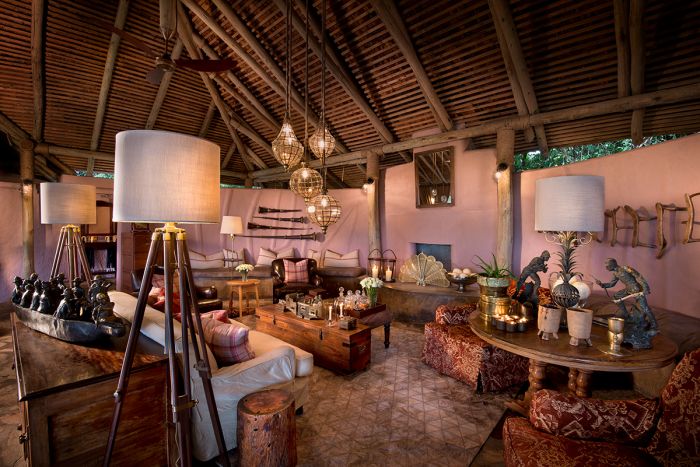
Main lounge area at Bateleur North Camp.
The camp's location on the edge of the uncrowded Mara Triangle means that guests to Bateleur will enjoy all of the Masai Mara wildlife without the crowds often found in the main section of the park to the east of the Mara River. The camp also offers quick access to the Mara River, which gives an excellent vantage point for seeing river crossings during the Great Migration.
Bateleur Camp comprises two separate but connected camps, each offering 9 tented guest suites. Two of the tents are connected via an enclosed passage that creates a double suite, which is perfect for families with two or three children. The front of each tent has a spacious viewing deck for relaxing during the midday.
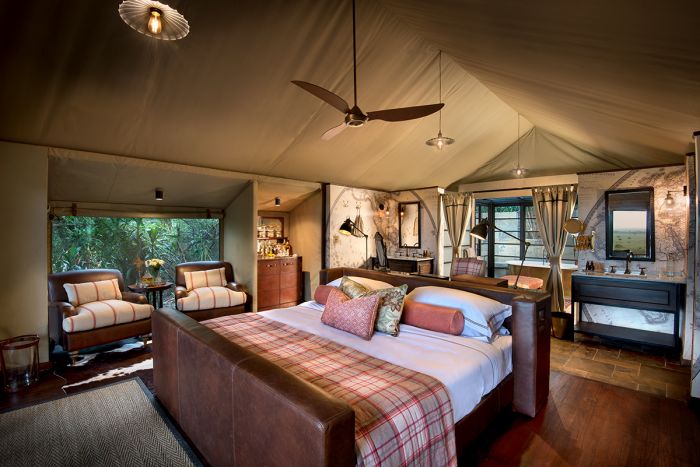
Guest tent interior at Bateleur Camp.
Each of Bateleur's satellite camps has its own separate main guest area with a lounge, dining area, bar, interactive kitchen, campfire area, and each with its own swimming pool and sundeck. All the guest tents and main areas have views out onto the plains of the reserve. The camps share a Wellness Centre offering massages and Healing Earth treatments, a fully-equipped gym, a traditional boma for outdoor dinners, and a Safari Shop.
AndBeyond are one of Africa's leading safari operators and they strive to minimize energy consumption at all their camps. Bateleur Camp is connected to the national grid with a backup generator available. Strict eco-friendly environmental standards are maintained so that no harmful chemicals or waste is allowed to enter the pristine ecosystem of the Masai Mara.
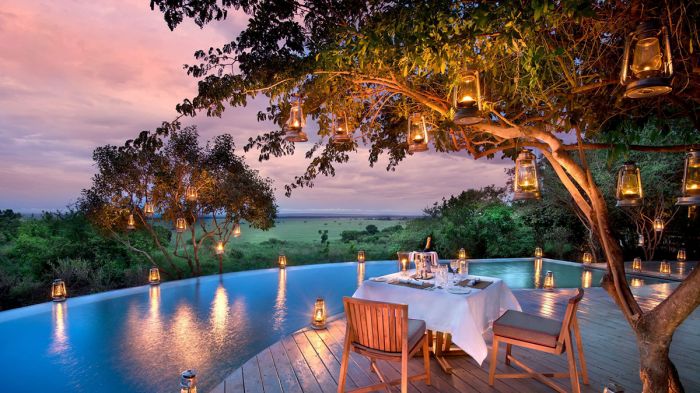
Doing beside the pool at Bateleur North Camp.
About the Masai Mara
The Greater Masai Mara includes the Masai Mara National Reserve as well as numerous private conservancies that border the reserve. The national reserve and bordering conservancies are often collectively referred to simply as "the Mara".
The Greater Masai Mara is part of a much larger ecosystem that includes vast protected areas directly to the south in Tanzania, including Serengeti National Park, the Ngorongoro Conservation Area, and other reserves that together make up the Greater Serengeti. The combined Greater Serengeti-Mara ecosystem, which combines the areas described above, covers roughly 15 000 square miles (39 000 sq kms).
The Serengeti-Mara is home to a very large number and diversity of wild animals and is also the location of the well-known "Great Migration" of over 2 million herbivores (read more below). This is arguably Africa's greatest overall wildlife destination.
Wildlife densities in the Greater Masai Mara are some of the highest in Africa, with commonly seen herbivores including blue wildebeest, plains zebra, Thomson's gazelle, topi, Grant's gazelle, hartebeest, giraffe, elephant, buffalo, impala, waterbuck, bush bug, warthog, and many others. Predators seen often include lion, leopard, spotted hyena, cheetah, serval, and jackal. Hippo and crocodile are found in large numbers in the Mara River.
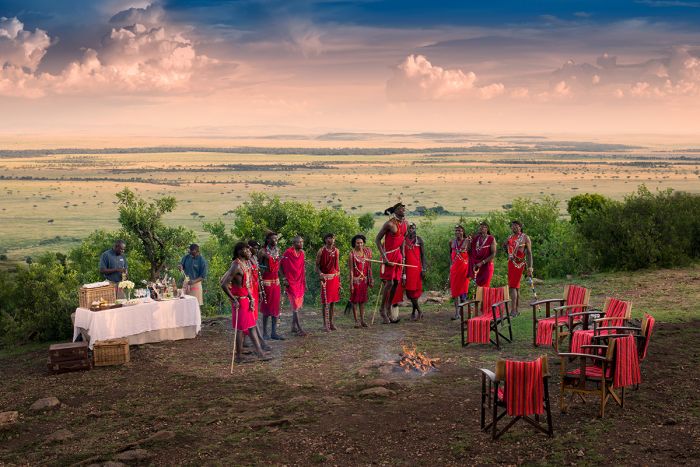
Dance performance by Maasai warriors for guests at Bateleur Camp with the plains of the Masai Mara below.
Masai Mara National Reserve
The national reserve forms the core protected area of the Greater Masai Mara, covering 583 square miles (1 510 sq kms) and officially protected since 1974. The reserve is functionally the same as a national park, with restrictions on off-road driving and open to the public, which includes self-drivers coming for the day, as well as guests staying at one of the accommodations within the reserve (of which there are many).
The Mara Triangle
The Mara River flows southward through the national reserve on its way into Tanzania and eventually into Lake Victoria to the southwest. The river also separates the national reserve into two separately-managed sections: the area to the west of the Mara River is known as the "Mara Triangle", while the area to the east of the river is simply the Mara National Reserve.
The Mara Triangle covers 197 square miles (510 sq kms), which is roughly one-third of the reserve and there are relatively few safari camps in this section, so the number of vehicles and tourists, especially during the peak months when the migration is in present, is much lower in the Triangle section than in the section east of the Mara River.
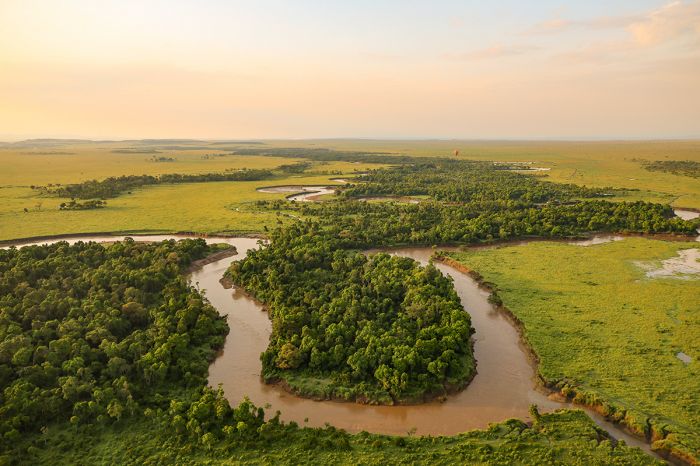
Hot-air balloon view of the Mara River as it snakes through the Masai Mara National Reserve.
The Great Migration
One of nature's greatest living spectacles is the Great Migration, a term given to describe the year-long, circular, clockwise march of over two million herbivores across the Masai Mara and Serengeti grasslands. The migration animals are made up entirely of two species: the blue wildebeest and the plains zebra (the majority of which are wildebeests).
The migrating herds follow their instincts to seek out fresh grazing and so the migration is ongoing, with the herds ever moving and taking a full year to complete a cycle across the Masai Mara and Serengeti. The animals move not as one herd, but as tens of thousands of animals in multiple herds of various sizes and spread out for many miles as they move.
The wildebeests and zebras take advantage of strongly seasonal conditions, spending the wet season (November through May) on the plains of Tanzania's Serengeti and the dry season in Kenya's Masai Mara. The wildebeests give birth between January and March on the short grass plains in Tanzania.
The timing of the migration is rarely ever the same year-to-year, as local conditions influence grass growth and as such, the location of the bulk of there animals cannot be known precisely. Rains and other unknown conditions seem to direct the timing of the migration, but generally, it is known within several weeks when the animals will be in a general location.
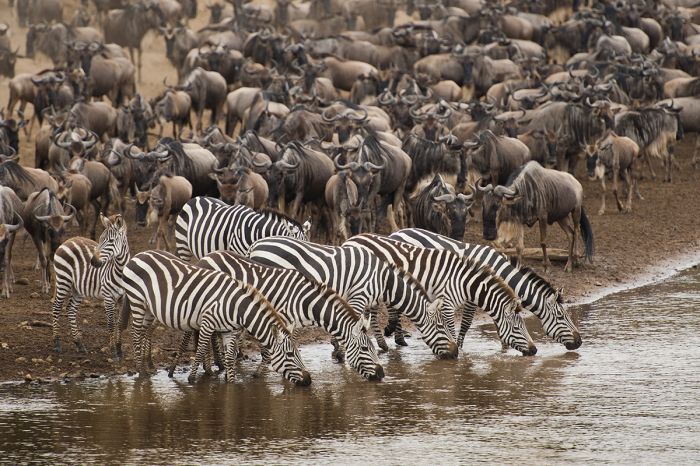
Wildebeests and zebras at the Mara River during the Great Migration.
The migration typically crosses north into Kenya and the Masai Mara beginning sometime in mid- or late-July and they spend around three months in the Greater Masai Mara. The herds head back south into Tanzania sometime in October.
Although many visitors time their visit to the Masai Mara to coincide with the Migration, the Greater Mara has superb wildlife viewing outside of the migration period. This is because it is only the wildebeests and zebras that migrate, the rest of the animals, including the major predators like lion, leopard, spotted hyena, and cheetah, as well as all the other herbivores, including springbok, gazelles, elephant, topi, hartebeest, and many others, do not migrate.
A popular aspect of experiencing the Great Migration is observing a herd as it crosses the Mara River, which requires animals swimming through waters inhabited by large Nile crocodiles that wait for a chance to get their first substantial meal in many months.
The dramatic river crossings (which take place along the Mara River in both Kenya and Tanzania) are certainly a spectacle and not for the faint of heart, with many of the wildebeest and zebras taken by crocs or succumbing to drowning or trampling in the chaos. The best chances for seeing a Kenya Mara River crossing are during July and August, when the crocodiles are still very hungry.
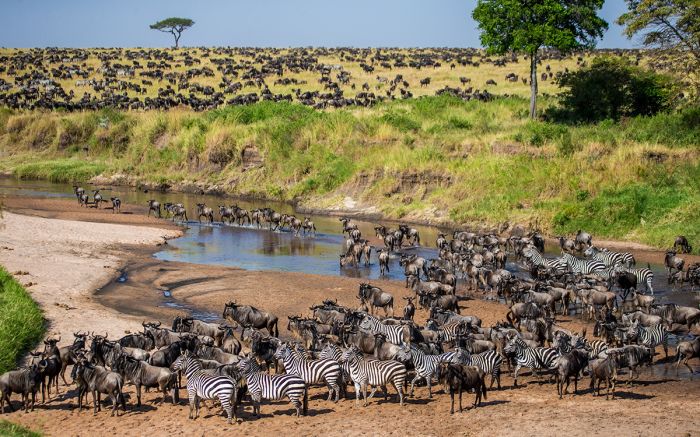
The Great Migration is certainly a spectacle to experience in person.
Mara Conservancies
Over the past two decades, nearly all of the land situated surrounding the Masai Mara National Reserve has been organized into protected and self-managed reserves by various tribes of the Maasai people that own the land. The result has been a great expansion of wildlife tourism and the construction of safari tourism camps and lodges.
Note that some of the conservancies use the name 'group ranch' instead of conservancy.
Many of these conservancies, particularly those that directly border the national reserve, offer wildlife viewing that is even just as good, and arguably even better than inside the reserve, primarily because the conservancies are only available to tourists staying at a camp within the conservancy and unlike the national reserve itself, are not accessible to self-drive day visitors.
The exclusivity of the conservancies means that there are fewer game drive vehicles and a far lower density of tourists. Further, the number of vehicles allowed at any specific animal sighting (such as a lion kill or a leopard in a tree) is managed to prevent the oft-seen situation where an animal, such as a cheetah, is surrounded by 20 or more cars in the national reserve.
Staying in one of the Mara Conservancies offers guests the opportunity to have an exclusive game-viewing experience (due to the reduced tourist numbers compared to inside the national reserve), while still allowing day visits into the reserve proper (entrance fee required). A day visit into the reserve might allow seeing a major wildebeest/zebra river crossing during the migration months. Guided safari walks (during the day) and game drives past sunset are another option inside the conservancies that is not permitted inside the national reserve.
ROOMS INCLUDES & EXCLUDES CHILDREN FACILITIES ACTIVITIES
Accommodation
18 guest accommodations in total comprised of two separate satellite camps situated next to each other and connected by footpaths.
Bateleur Camp North
9 guest accommodations in total comprising:
- 9 twin-bedded wood and canvas suites (2 of which are convertible into a double/family suite), each with two extra-length three-quarter beds (separate mattresses with shared base) and outdoor deck. Mattress converters are available that transform twin beds into king-size beds (to be arranged prior to arrival).
- Suites 8 and 9 in North Camp are connected by an inter-leading interior corridor, making it ideal for a family. There is a private interior lounge with seating and a private dining table situated between the two tents and accessed by the corridor. The Family Suite can accommodate two adults and two children (three children can be provided for on request).
Bateleur Camp South
9 guest accommodations in total comprising:
- 9 twin-bedded wood and canvas suites (2 of which are convertible into a double/family suite), each with two extra-length three-quarter beds (separate mattresses with shared base) and outdoor deck. Mattress converters are available that transform twin beds into king-size beds (to be arranged prior to arrival).
The tented accommodations in both satellite camps are constructed on a slightly elevated deck with footpaths on the ground leading to the main camp area. All suites include en-suite facilities with two, separate, single-basin vanities, indoor shower, outdoor shower, bathtub, and separate toilet.
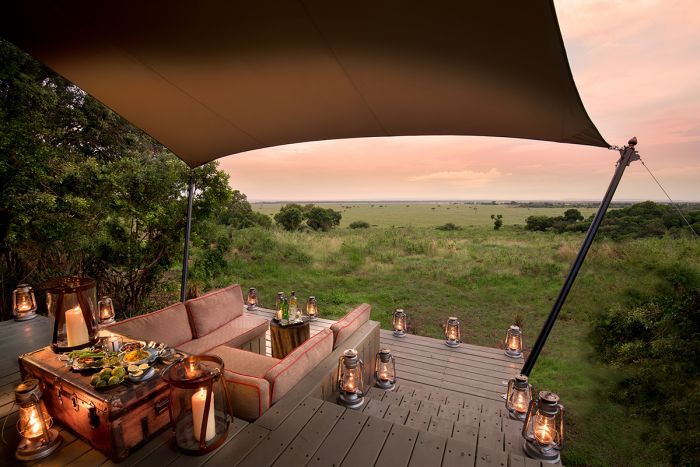
Guest tent front deck and view.
The suites' tasteful interiors include handcrafted artifacts, fine antiques, and Chesterfield sofas. At the rear of the suite is a private courtyard enclosed by a stone wall (this is also where the outdoor shower is located). The interior bathroom includes a weather-protected 'star-bath' with sky views.
At the front of each tented suite is a spacious outdoor deck with a comfortable daybed overlooking the plains of the Masai Mara.
The suites are comfortable in size, covering 700 square feet (65 sq meters) in area. The distance between the guest suites is approximately 10 feet (33 meters).
Other items and features in the guest cottages and suites include:
- Personal bar and coffee station.
- Private daybed on the outdoor deck.
- Healing Earth treatments offered in-room or in the Massage Sala.
- Gym-in-a-basket with yoga mat, etc.
- Complimentary pair of Swarovski binoculars (one per suite).
- In-room Wi-Fi (also available in main guest areas).
- Overhead fan.
- Telephone.
- Hairdryer.
- In-room safe.
Bateleur Camp can accommodate a maximum of 38 guests in total: 2 persons in each of the 18 tented suites and 2 allowable triples.
Includes & Excludes
Includes:
- All meals and local beverages including soft drinks, house wines, local brand spirits and beers, teas, and coffees.
- Safari experiences (twice-daily game drives, one-hour nature walks, birding, Maasai dances, Maasai talks, and cultural visits to a Maasai village), all accompanied by an experienced guide.
- Laundry services are provided on a daily basis (weather permitting, items will be returned on the same day). Laundry is dried by the sun and on most days any laundry placed out in the morning will be returned by the evening.
- A complimentary pair of Swarovski Optik CL Companion 8×30 binoculars per suite for use during your stay.
- Emergency medical evacuation insurance.
- Wi-Fi access.
- Tourism Levy & VAT.
Excludes:
- Champagne, cognacs, fine wines, premium brand spirits, and cigars.
- Hot-air balloon adventures.
- Purchases from the Safari Shop.
- Spa / wellness treatments.
- Any applicable wildlife fee, park fee, reserve fee, concession fee, other land-use fee.
Single Supplement
A single supplement may apply for any room booked by a single traveler; please ask us for pricing.
Children
Travel to Kenya is recommended for children eight years or older. Children five years and younger cannot participate in regular game drives; children aged six to 11 can participate in regular game drives at the lodge manager’s discretion.
Families can rest assured that your children will always be safe and well cared for (both during activities and at the camp) by the lodge staff.
Children of any age are accommodated at Bateleur Camp:
- Two triple rooms are available between North and South camps.
- Children under the age of 6 years are not permitted on game drives.
- Children aged 6-11 years are permitted on game drives at the discretion of the ranger (private vehicle required).
- Children aged 6-15 years are not permitted on nature walks outside of the camp grounds.
- Children aged 12-15 years are permitted on game drives (private vehicle required).
- Private vehicle not required for children aged 16 years and older.
- Children aged 16 and above are permitted on specialist walking safaris.
- Children that share a vehicle with other guests not in their party may be subject to activities only at the lodge manager’s discretion.
- Please note: Even though the camp is fenced off, children are required to have an adult accompanying them at all times.
AndBeyond’s WILDchild program, designed especially for children aged 3-12 years, is filled with fun, interactive activities that offer opportunities to learn and discover new experiences and cultures. Deeply rooted in the love for the African bush, it not only creates a series of unforgettable moments for the whole family, but forges strong bonds between young guests, our planet, and its people.
- Activities include nature walks, Maasai spear-throwing, fire-making the Maasai way, soccer with the camp’s team, visit to a nearby Maasai village, prepare a ranger’s omelette breakfast on a game drive, create colorful beadwork, and more.
- While the camp does not have trained child minders, it can offer the services of certain staff members who are wonderful with children. This will be at an additional cost (best to pre-book this with us).
Facilities
Bateleur Camp comprises two satellite camps (North Camp and South Camp), each with its own main guest area, offering an expansive vista across the plains of the Mara Triangle. The main guest areas are constructed atop a slightly raised wooden deck with a high-pitched thatch roof and a canvas covering above.
The main areas at both camps are decorated with handcrafted artifacts, fine antiques, leather-buttoned Chesterfield sofas, and books. Crystal and candlelight adorn the comfortable sitting and dining areas.
Other features of the main areas include:
- Refreshing swimming pool and sundeck at each camp.
- Campfire area at each camp.
- Massage Sala located between the camps (massages and Healing Earth treatments also available in-suite).
- Well-equipped gym located between the camps.
- Safari Shop located between the camps.
- Traditional boma in South Camp.
- Interactive kitchens in both camps.
- Complimentary Wi-Fi.
- Guest toilets in the main areas at both camps.
Activities
Activities included in the rate:
- Twice-daily game drives (staying out past sunset is allowable) in open 4x4 Land Cruisers (4 guests per vehicle).
- A complimentary pair of Swarovski Optik CL Companion 8×30 binoculars per guest cottage for use during your stay.
- Guided bush walks.
- Birding.
- Maasai performances.
- Maasai talks.
Optional activities at additional cost:
- Private activities are on offer (subject to vehicle availability which needs to be booked in advance).
- Hot-air ballooning.
- Community visit to a Maasai boma.
- Wellness treatments (offered in Massage Sala or in-suite).
Example of a typical day:
- Early morning wake-up call. Morning wake-up and activity times vary according to the seasons, activities on offer, and wildlife sightings.
- Light breakfast before departing on the morning activity.
- Return to the lodge for a meal and rest period.
- Meet for afternoon tea and snacks (savory and sweet choices) before departing on the activity.
- Return to camp - freshen up or meet for drinks, followed by dinner.
- Enjoy a nightcap and/or discussion at the bar or around the campfire before retiring.
Great Good Fair Poor
- Jan
- Feb
- Mar
- Apr
- May
- Jun
- Jul
- Aug
- Sep
- Oct
- Nov
- Dec
General Tips
The best time to visit the Masai Mara is during the dry season, between June and October, which also happens to coincide with the arrival of the Great Migration into Kenya (read more about this below).
Besides the Great Migration, the other big factor that impacts a stay in the Mara is rains. The region experiences most of its rain between November and May, but there are two somewhat distinct rain seasons, the 'short' rains and the 'long' rains.
Bateleur Camp is open year-round.
Rain Season
Short Rains
The short rains occur for about one month sometime during November and December (the exact time varied somewhat year to year). This period is called the 'short' rains because the duration of an individual rain event is short and it is rare to have an all-day rain event. Most rain falls as an afternoon shower, while mornings are typically overcast or clear.
Long Rains
The long rains occur between March and May, with April being the wettest month of the year. During this tome, rain should be expected almost every day and the showers can last for hours at a time, although all-day rain is not typical. The roads in the Masai Mara become muddy and very difficult in places, which can hamper game drives. Cloudy skies are typical and temperatures can be chilly at times.
The period between the short and long rains (January and February) also receives rain, but many days are clear and the amount and duration of the rain events is unpredictable, with some afternoon showers and the odd long and heavy rainfall event.
Temperatures
The temperatures in the Greater Masai Mara do not have great variation throughout the year, as the region lies approximately 1 degree south of the equator. In general, daytime temperatures are comfortably warm and overnights and early mornings are chilly. Bring a fleece and rain jacket regardless of the timing of your visit.
Dry Season
The dry season (June to October) is sunny and warm most days and rarely hot. Rare rain showers can occur but are unlikely. From June thru August, the afternoon temperature averages 76-78°F (24-25°C), but some days can be warmer. Evenings and early mornings temperatures are often chilly, averaging 53-55°F (12-13°C).
September and October days are very pleasant, with temperatures averaging 80-83°F (28-30°C), with cool mornings persisting, averaging 53-56°F (11-13°C).
Rainy Season
The rain season is November through May (read more above) and the temperatures are fairly static throughout the season. Daytime temperatures average 79-83°F (26-28°C) and nighttime and early morning temperatures are chilly, but slightly warmer than the dry season, averaging 54-57°F (12-14°C).
The Great Migration
The annual movement of wildebeest and zebras across the Serengeti-Mara ecosystem is one of the greatest spectacles in the natural world. Many people visiting Kenya's Masai Mara (or the Serengeti in Tanzania) will time their visit to be able to experience the Great Migration of over two million animals (all of them blue wildebeests and plains zebras).
The migration moves across both the Greater Masai Mara (in Kenya) and the Greater Serengeti (in Tanzania) in a fairly consistent pattern and timeframe. The animals move to take advantage of fresh grasses on which to graze.
The large herds are well spread out, but follow a roughly clockwise and somewhat circular track across southern Kenya and northern Tanzania, taking a full year to complete. The migrating herds are in Kenya's Greater Masai Mara from around late July until sometime in October (note that the timing is never precise and varies somewhat year to year).
The wildebeests and zebras are taking advantage of the strongly seasonal conditions, spending the wet season on the northeastern plains of Tanzania and the dry season on the plains of southwestern Kenya. The wildebeest give birth between January and March on the short grass plains in Tanzania.
The migration is rarely ever the same in terms of precise timing and direction, as local conditions influence grass growth. The wildebeest may, therefore, move off the open plains earlier in some years and remain in the northern woodlands for longer in others.




